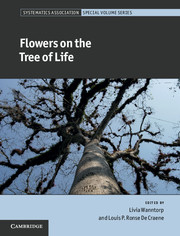Book contents
- Frontmatter
- Contents
- Contributors
- Acknowledgements
- 1 Introduction: Establishing the state of the art – the role of morphology in plant systematics
- 2 Spatial separation and developmental divergence of male and female reproductive units in gymnosperms, and their relevance to the origin of the angiosperm flower
- 3 New flowers of Laurales from the Early Cretaceous (Early to Middle Albian) of eastern North America
- 4 Tracing the early evolutionary diversification of the angiosperm flower
- 5 Changing views of flower evolution and new questions
- 6 Centrifugal stamens in a modern phylogenetic context: was Corner right?
- 7 Evolution of the palm androecium as revealed by character mapping on a supertree
- 8 Comparative floral structure and development of Nitrariaceae (Sapindales) and systematic implications
- 9 Multiplications of floral organs in flowers: a case study in Conostegia (Melastomataceae, Myrtales)
- 10 Ontogenetic and phylogenetic diversification in Marantaceae
- 11 Floral ontogeny of Acacia celastrifolia: an enigmatic mimosoid legume with pronounced polyandry and multiple carpels
- 12 Floral development of Napoleonaea (Lecythidaceae), a deceptively complex flower
- Taxon index
- Subject index
- Plate section
10 - Ontogenetic and phylogenetic diversification in Marantaceae
Published online by Cambridge University Press: 07 October 2011
- Frontmatter
- Contents
- Contributors
- Acknowledgements
- 1 Introduction: Establishing the state of the art – the role of morphology in plant systematics
- 2 Spatial separation and developmental divergence of male and female reproductive units in gymnosperms, and their relevance to the origin of the angiosperm flower
- 3 New flowers of Laurales from the Early Cretaceous (Early to Middle Albian) of eastern North America
- 4 Tracing the early evolutionary diversification of the angiosperm flower
- 5 Changing views of flower evolution and new questions
- 6 Centrifugal stamens in a modern phylogenetic context: was Corner right?
- 7 Evolution of the palm androecium as revealed by character mapping on a supertree
- 8 Comparative floral structure and development of Nitrariaceae (Sapindales) and systematic implications
- 9 Multiplications of floral organs in flowers: a case study in Conostegia (Melastomataceae, Myrtales)
- 10 Ontogenetic and phylogenetic diversification in Marantaceae
- 11 Floral ontogeny of Acacia celastrifolia: an enigmatic mimosoid legume with pronounced polyandry and multiple carpels
- 12 Floral development of Napoleonaea (Lecythidaceae), a deceptively complex flower
- Taxon index
- Subject index
- Plate section
Summary
Introduction
The Marantaceae Petersen (31 genera; ~530 ssp.: Andersson, 1998) are a pantropically (80% America; 11% Asia; 9% Africa: Kennedy, 2000) distributed family of perennial herbs and lianas found in the understory of tropical lowland rainforests. They are characterized by a unique pollination mechanism combining secondary pollen presentation with an explosive style movement (Kunze, 1984; Claßen-Bockhoff, 1991; Claßen-Bockhoff and Heller, 2008a). The specific pollen transfer mechanism is found in conjunction with a high synorganization of morphologically modified floral elements and has been postulated to be a key innovation responsible for the radiation of the Marantaceae (Kennedy, 2000).
Flowers in Marantaceae are trimerous, with inconspicuous sepals and petals and extremely modified elements in the two androeceal whorls (Fig 10.1). In the outer whorl one or two petaloid ‘outer staminodes’ act as the showy organs of the flowers. The three elements of the inner whorl are functionally differentiated into: (1) a single (monothecate) anther, (2) a ‘fleshy (callose) staminode’ and (3) a ‘hooded (cucullate) staminode’ (Kunze, 1984; Claßen-Bockhoff, 1991). These organs closely interact with the style resulting in secondary pollen presentation, set-up of tension and finally the explosive pollination mechanism (e.g. Gris, 1859; Delpino, 1869; Schumann, 1902; Yeo, 1993; Claßen-Bockhoff and Heller, 2008a, b; Ley, 2008; Pischtschan and Claßen-Bockhoff, 2008; Fig 10.2). As the style movement demands a high degree of synorganization of floral parts and synchronization with the pollinator and as the movement is irreversible, providing the flowers with a single opportunity for pollination, one should expect rather uniform structures across the whole family, as slight morphological deviations might result in a loss of operability. However, the high degree of floral diversity in the Marantaceae contradicts this expectation (Kunze, 1984; Kennedy, 2000; Claßen-Bockhoff and Heller, 2008a; Ley, 2008). It instead raises the questions: how far are elements of a functional unit allowed to vary without jeopardizing the reproductive success, and has the variation of the flowers influenced speciation in the family?
- Type
- Chapter
- Information
- Flowers on the Tree of Life , pp. 236 - 255Publisher: Cambridge University PressPrint publication year: 2011
- 2
- Cited by

